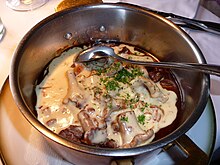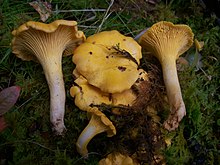Real chanterelle
| Real chanterelle | ||||||||||||
|---|---|---|---|---|---|---|---|---|---|---|---|---|

Chanterelle ( Cantharellus cibarius ) |
||||||||||||
| Systematics | ||||||||||||
|
||||||||||||
| Scientific name | ||||||||||||
| Cantharellus cibarius | ||||||||||||
| Fr. |
The True chanterelle , chanterelles or Rehling ( Cantharellus cibarius ), including chanterelles , in Austria and Bavaria chanterelles and Reherl , in Franconia Gelberle in Saxony Gelchen in which Switzerland also chanterelles called, is a cooked edible and traded as market mushroom fungus from the family the chanterelle relative .
features
The characteristic features of the real chanterelle are the shape and color of the hat and stem of the fruiting bodies . The yolk to golden yellow hat has a diameter of 2 to 9, rarely up to 15 centimeters, initially has a hemispherical to arched shape, which then turns inside out to a funnel-shaped. The edge of the hat is irregularly wavy and often later curved. The underside of the hat is covered with comparatively low and more or less wide, veiny , often forked and anastomosing (interconnected) ridges that run down the handle and gradually run out. The hat-colored stem is short (3 to 6, rarely up to 8 centimeters long), usually 1 to 2 centimeters thick, often curved, tapering downwards and gradually merging into the hat upwards and with a full flesh. The meat is crisp, firm, tough and fibrous in the handle, whitish to pale yellow in color, tastes mild to peppery (hence the origin of the word) and, in fresh specimens, smells finely fruity (like apricots ). The spores appear en masse as pale yellow spore powder, measure 8 to 10 by 4.5 to 5.5 micrometers, and are ellipsoidal in shape. They show no color reaction ( inamyloid ) with iodine reagents .
Ecology and phenology
The real chanterelle is a mycorrhizal fungus that enters into symbiosis with various coniferous and deciduous trees. In Central Europe, the preferred tree partner is the common spruce , followed by the red beech . In addition, the mushroom can be associated with oaks , pines and firs , and rarely with linden trees. The real chanterelle colonizes various forest types on moderately dry, base and nutrient-poor soils. In limestone areas only superficially acidic soils are colonized. It often grows very “socially” in young plantings and in more or less open areas that are only sparsely overgrown with grasses, shrubs and mosses.
The fruiting bodies of the real chanterelle appear in Central Europe from June to November.
distribution
The real chanterelle is found in Australia, South America, North Asia, North America and Europe. The chanterelle is widespread in Europe.
Population development and endangerment
All species of chanterelles are under nature protection in Germany, they are listed in Appendix 1 as "specially protected" according to the Federal Species Protection Ordinance. They may be collected in small quantities for personal use.
The real chanterelle is a fairly common mushroom. The risk factors include long-term lack of precipitation, lowering of the groundwater level, forest interventions and soil compaction by forest machines and heavily trodden forest areas. For Baden-Württemberg, the chanterelle is classified in risk group G 3 (currently still frequent, but with a significant tendency to decline).
The species is also "endangered" in Austria and is therefore protected in all federal states. Usually this means that, like other types of mushrooms, it can only be harvested by private individuals up to a maximum amount of two kilograms.
meaning
Food value

The real chanterelle has been a popular edible mushroom since ancient times and is traded in large quantities. Chanterelles offered in Germany mostly come from East Central European, Baltic and Eastern European countries, but also from the Atlas Mountains.
Idioms
With: “This is (to me) not worth a damn!” One expresses a low appreciation for a thing or a person. It is controversial whether there is a connection with the fungus. The assumption that the phrase is due to the (over) abundant supply of this mushroom is obvious; More likely, however, is the origin from the southwest German dialect, where a five-pfennig piece is called Pfifferle. “Such a wrong chanterelle!” (I. D. R .: a person of dubious character ) may have arisen from the confusion with this very person .
Postage stamps
Postage stamp from the GDR (1980)
Postage stamp from Romania (1958)
Postage stamp from Moldova (1995)
Postage stamp from the Soviet Union (1964)
variability
The real chanterelle varies greatly, Corner (1966) lists up to 18 different varieties worldwide . Krieglsteiner (2000) only granted two varieties of taxonomic rank that are now species-level: violet-scaly chanterelle ( Cantharellus amethysteus ) and pale chanterelle ( Cantharellus pallens ). On the other hand, Eyssartier & Buyck (2000) recognize seven taxa in addition to the type variety:
| German name | Scientific name | Author quote |
|---|---|---|
| Blower Chanterelle | Cantharellus cibarius var. Albidus | May 1937 |
| Atlantic chanterelle | Cantharellus cibarius var. Atlanticus | Romagnesi 1995 |
| Two-colored chanterelle | Cantharellus cibarius var. Bicolor | May 1937 |
| Flesh pink chanterelle | Cantharellus cibarius var. Carneoalbus | (R. Heim 1960) Corner 1966 |
| Hazel Chanterelle | Cantharellus cibarius var. Flavipes | R. Heim 1960 ex Eyssartier & Buyck 2000 |
| Brown scaly chanterelle | Cantharellus cibarius var. Squamulosus | (A. Blytt 1905) Eyssartier & Buyck 2000 |
| Rusty brown chanterelle | Cantharellus cibarius var. Umbrinus | R. Heim 1960 ex Eyssartier & Buyck 2000 |
On the basis of recent genetic investigations, some of these varieties have been revised or declared to belong to other species: For example, var. Squamulosus and var. Umbrinus to the violet-scaly chanterelle ( C. amethysteus ), var. Albidus and var. Bicolor to the pale chanterelle ( C. pallens) and var. flavipes to Cantharellus ferruginascens .
Species delimitation

Wrong chanterelle
The classic double of the chanterelle is the false chanterelle ( Hygrophoropsis aurantiaca ). Despite its name, the species is in the order of the thick tubule-like and thus far removed from the relationship. It differs from the real chanterelle in some features: In contrast to the veiny ridges of the chanterelle, which are about as thick as they are high, the false chanterelle has lamellae . While ridges are actually protruding wrinkles in the continuous fruit layer , lamellae stand individually; they are like thin book pages.
The smell of the false chanterelle is inconspicuously mushroom, not pleasantly fruity like that of the real chanterelle. In addition, the fake chanterelle has soft, pliable flesh and not crisp and firm like the real one. In typical forms, the two species also differ in color: the false chanterelle is more intensely orange in color, the real chanterelle yellow without orange tones. However, lighter color forms can occur in both types.
Olive mushrooms and veils
It would be dangerous to mix it up with the poisonous luminous olive mushroom ( Omphalotus illudens ). He loves warmth and is very rare in Germany. The luminous olive mushroom also has lamellas instead of strips, it is also long-stemmed and grows in tufts on hardwood. It is more orange in color and glows faintly in the dark.
A mix-up with veils like the pointed hunched rough head ( Cortinarius rubellus ) would be life-threatening. The rust-brown lamellar mushroom differs so clearly in color, shape and smell that only very young, still closed specimens could be confused by inattentive collectors.
Other chanterelles
Differentiating it from other species of the genus can be difficult, but like the common chanterelle, they are all edible.
The velvety chanterelle ( Cantharellus friesii ) is smaller and more delicate and has a more intense orange color. The pale chanterelle ( C. pallens ) has a much paler cap with whitish tires and only grows in deciduous trees. The purple-scaly chanterelle ( C. amethysteus ) has a purple-tinged coating in the middle of the hat that breaks up into small scales. The olive-yellow rust-spot chanterelle ( C. ferruginascens ) also only occurs in deciduous trees and differs in its whitish ridges, rust-red staining flesh and a more cool lemon-yellow hat color, at least on the edge of the hat.
Web links
Individual evidence
- ↑ nordbayern.de, Nürnberg, Germany: Gelberle found at the beginning of January . ( nordbayern.de [accessed on July 28, 2018]).
- ↑ [1] page "Wissen.de"
- ↑ Hans E. Laux: The great cosmos mushroom guide. All edible mushrooms with their poisonous doppelgangers. Franckh-Kosmos, Stuttgart 2001, ISBN 3-440-08457-4 , p. 454.
- ↑ Hans E. Laux: Edible mushrooms and their poisonous doppelgangers . Collect mushrooms - the right way. Kosmos Verlags-GmbH, Stuttgart 2005, ISBN 978-3-440-10240-4 , p. 167 .
- ↑ Markus Flück: Which mushroom is that? 3. Edition. Franckh-Kosmos Verlag, Stuttgart 2009, ISBN 978-3-440-11561-9 , pp. 306 .
- ↑ Gerlinde Hausner: Mushrooms . The most important edible and poison mushrooms. 2nd Edition. BLV Verlagsgesellschaft mbH, Munich 1991, ISBN 3-405-13811-6 , p. 20 .
- ↑ Ordinance on the protection of wild animal and plant species (Federal Species Protection Ordinance - BArtSchV) Annex 1 (to Section 1)
- ↑ Fungal protection as an example, the website of the Salzburg state government (accessed on October 18, 2018).
- ^ Edred John Henry Corner: A monograph of Cantharelloid fungi . Oxford University Press, London (UK). 1966.
- ^ German Josef Krieglsteiner (Ed.), Andreas Gminder , Wulfard Winterhoff: Die Großpilze Baden-Württemberg . Volume 2: Stand mushrooms: inguinal, club, coral and stubble mushrooms, belly mushrooms, boletus and deaf mushrooms. Ulmer, Stuttgart 2000, ISBN 3-8001-3531-0 .
- ↑ Guillaume Eyssartier, Bart Buyck: Le genre Cantharellus en europe - nomenclature et taxinomie . In: Bulletin de la Société Mycologique de France 116 (2). 2000. Pages 91-137.
- ↑ a b Ibai Olariaga, Gabriel Moreno, Jose Luis Manjón, Isabel Salcedo, Valérie Hofstetter: Cantharellus (Cantharellales, Basidiomycota) revisited in Europe through a multigene phylogeny . In: Fungal Diversity . tape 83 , no. 1 , March 2017, ISSN 1560-2745 , p. 263–292 , doi : 10.1007 / s13225-016-0376-7 ( springer.com [accessed May 18, 2020]).








